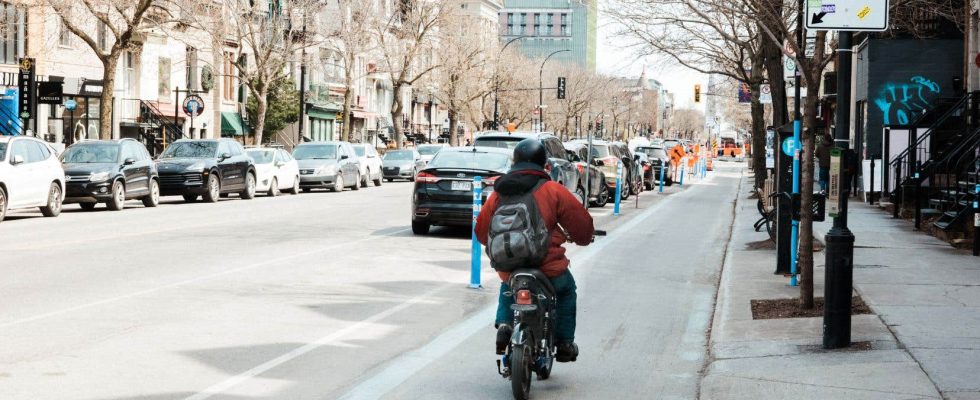The presence of electric scooters on Quebec bike paths is coming to an end. According to what The duty has learned, the Legault government is working on a project aimed at ending the sometimes perilous cohabitation between bicycles and certain electric vehicles which are more akin to motorcycles than to bicycles.
Montreal’s bikeways broke attendance records with the return of good weather last week. This strong start to the cycling season has highlighted the growing tensions between traditional bicycles and electric scooters.
“It is becoming urgent to act on this. We are told: “Come on, these are bike paths, they go fast, they go overboard, we don’t feel safe with the children,” says Marianne Giguère, associate advisor for active mobility at the City of Montreal. The elected official is part of a working group set up by the Ministry of Transport which is preparing amendments to the Highway Safety Code to regulate the proliferation of electric vehicles.
There has been talk for a decade of banning electric scooters from bike paths, but this time is the right one, assure our sources.
The emergence of so-called electric “bicycles” which have all the characteristics of a scooter is causing friction between users. These mini motorcycles are equipped with pedals whose only function is to qualify them as electric bicycles, argue speakers who are familiar with the file.
“These devices raise questions about the issues of cohabitation and safety on public roads, especially on bike paths, considering, for example, their weight and speed,” confirms Geneviève Côté, spokesperson for the Société de l’ assurance automobile du Québec (SAAQ), which is part of the working group on the regulation of electric bicycles.
“Their resemblance to a moped or a motorcycle also raises questions in the police community and among some road users, among other things with regard to the places where these devices are authorized to circulate”, she specifies.
A vagueness to dissipate
Only unregistered vehicles can legally drive on cycle lanes. However, the proliferation of electrically powered modes of travel complicates the enforcement of the law. In Montreal, for example, bike paths are officially reserved for bicycles and scooters (or quadriporteurs), these small electric vehicles popular with the elderly.
In reality, a series of users compete for the little space on the cycle paths: in addition to electric scooters, scooters, skateboards, joggers, pedestrians, wheelchairs and inline skates compete with cyclists. A simple bike ride is enough to see the conflicts between all these people on the move.
The definition of a bicycle is becoming so blurred that actual electric scooters — without pedals, those — are sneaking into bike lanes with impunity. These vehicles, as heavy and powerful as gasoline scooters, give cyclists a cold sweat.
Vélo Québec is one of the organizations consulted on the regulation of electric vehicles. The Ministry of Transport working group is due to meet in the coming days. “Our number one goal, everyone around the table, is to ban electric scooters from bike paths,” says Magali Bebronne, program director at Vélo Québec.
Speed and weight
Under current regulations in Quebec, an electric bike has a maximum power of 500 watts and can reach a maximum speed of 32 km/h. An electric scooter has no power limit, but can travel up to 70 km/h. This type of vehicle must be registered, unlike bicycles. And scooter riders must wear a motorcycle helmet.
These standards come from the federal government. However, Ottawa warned the provinces in February 2020 that they would have to put in place their own framework for electric bicycles. The Legault government is working on this file.
Speed and weight limits are among the criteria mentioned by the organizations gathered around the table to better define what a “bicycle” is. Some have proposed limiting the speed of e-bikes to 25 km/h, as in several European jurisdictions. But simple pedal bikes can reach much higher speeds.
Others suggest that accelerating from the grip should be reserved for scooters or motorcycles. The presence of a step – incompatible with pedals – could also designate a scooter.
We play elbows
The cyclists encountered on the very busy trails of Montreal believe that a helm is needed to better regulate the types of users. “I admit that scooters are scary: they’re not noisy and they go fast,” says Paul Gauthier, met outside the Maison des Cyclists, at the corner of Rachel and Brébeuf streets, on Le Plateau-Mont-Royal.
On this sunny day last week, the Rachel Street bike path was busy. Paul Gauthier believes that cyclists must learn to share bike lanes with all other types of users – except scooter enthusiasts, who should ride in the street, according to him.
“We are moving towards more bicycles, scooters and other active means of transport. The public road is shared. You have to be inclusive,” he says. This cycling enthusiast dares to believe that people will learn to mix with each other, to respect each other and to slow down a bit on cycle paths.
“It’s true that things go fast, and not just scooters: I’m on an electric bike and I’m overtaken by ordinary bikes,” says Joanne, a retiree who has been riding two wheels for 25 years in Montreal. Then, she adds: “What irritates me are the old people with their electric carriages and the young people on scooters or in skateboard. But they have to go somewhere. I imagine we’ll get used to it. »
